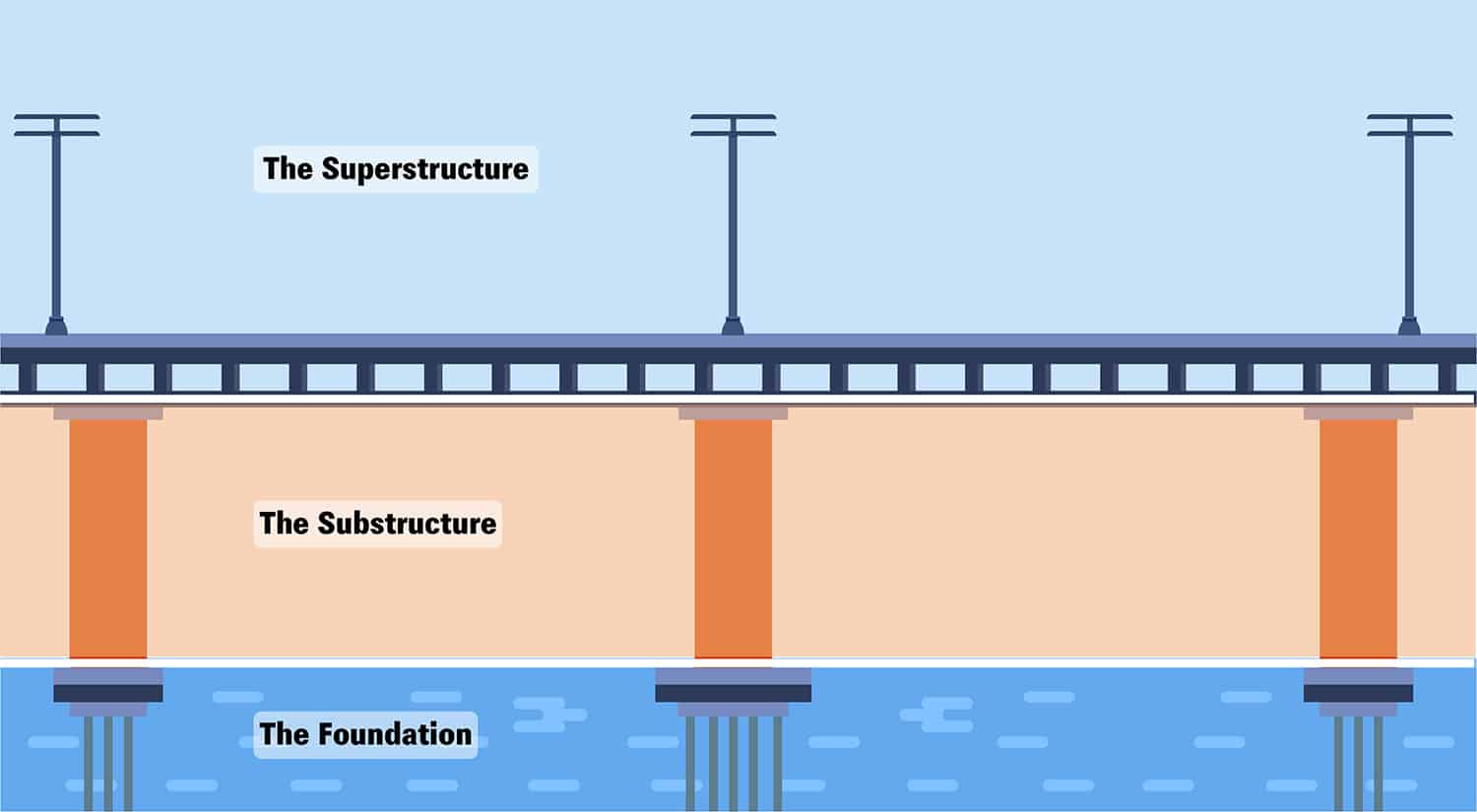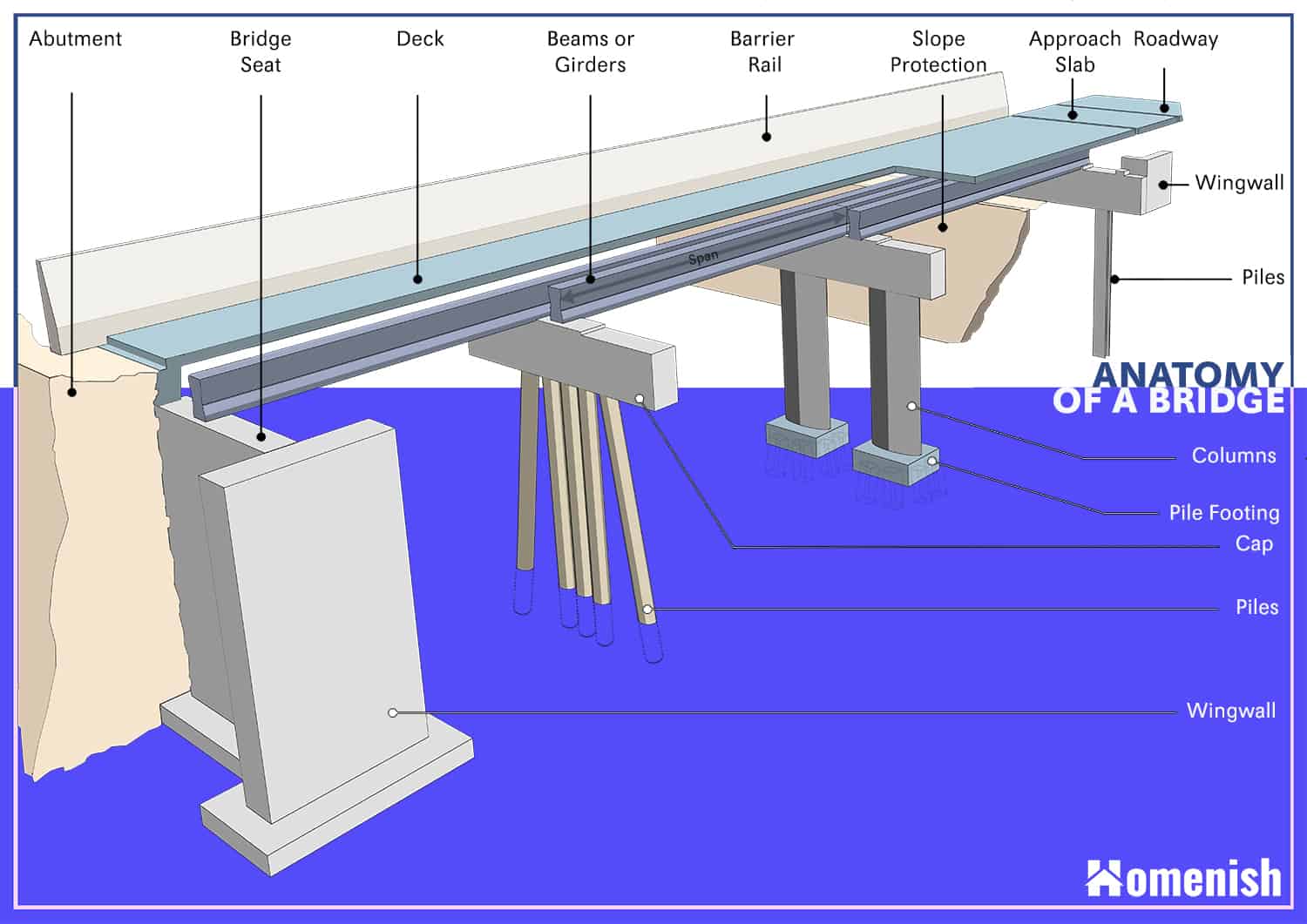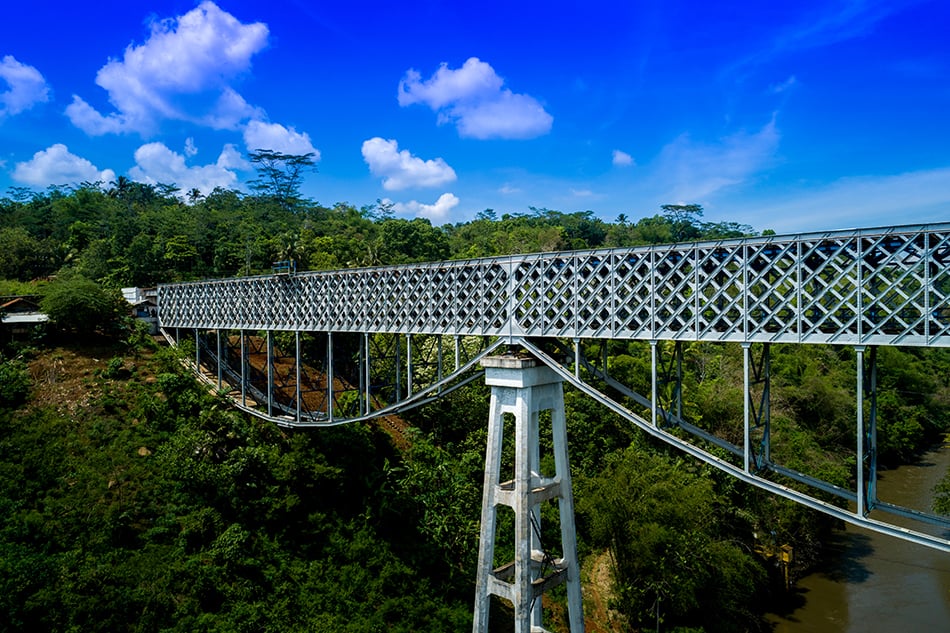Bridges are of several types, some of which include beam bridges, arch bridges, cantilever bridges, suspension bridges, truss bridges, cable-stayed bridges, and tied arch bridges. Many bridges were built to last centuries. For instance, the Golden Gate Bridge in San Francisco, which was opened in 1937, took a total of four years to build and is one of the most famous bridges in the world.
This article will go into details about the various parts of a bridge and how they function, illustrated by two amazing custom diagrams.
History of Bridges
Humans have always needed a quick way to move across natural obstacles on roads such as bodies of water, valleys, and rough terrains, so the concept of building bridges has existed for as far back as anyone alive can remember. In ancient times, bridge-building started in Mesopotamia with man-made materials.
At first, these bridges were simply made from natural materials such as stones, logs of wood, dirt, etc. They hardly covered very long distances and usually had structural integrity that was below average. Back then, there were no mortars, so most bridges built were fragile and easily destroyed by rain.
Finally, with continuous innovation, ancient Rome engineers started to use ground-out volcanic rocks to make mortar. This was the first step to the great revolution in the bridge construction business, as this invention allowed ancient engineers to build bridges that were a lot more impressive, stronger, and bigger than had ever been seen in any civilization. It wasn’t long before all other parts of the world began to make similar bridges building powerful roads and connections to far-away places.
Today, you’ll find impressive and very high-quality bridges in every part of the world.
Main Parts of a Bridge
Bridges have three major parts, each of these parts has other components, and they include:

Below you will find a detailed diagram that illustrates all the detailed components of a bridge.

The Foundation
Piles
Piles could be made from several materials; the material with which they are made usually depends on ground stability, soil type, load-bearing capacity, among other considerations. As a rule, piles are laid down to provide support to the initial foundation of a bridge. Piles ensure that every stress or weight applied on the bridge is spread evenly through the ground. This makes the bridge a lot stronger.
Caps
You’ll find the caps of a bridge right on top of the piles, which is the reason they are also sometimes called the pile cap. Caps provide the utmost strength to the upper part of the bridge. They also support the piles in transferring load and stress evenly through the ground. They are made of very heavy concrete so that they do the best job of providing support for the upper part of the bridge.
Bents
Bents is simply a name that describes piles and caps placed together. The foundation of every bridge is made up of multiple bents.
The Substructure
Abutments
These are retention walls for the ground of the bridge. Usually constructed with reinforced concrete, abutments act as vertical supports at their approaching ends of a bridge and can withstand a huge amount of horizontal force.
Piers
These are supports mounted at several spans on a bridge to support the structure from vibrations and other forces.
Pier Caps
This is the bearing part of a bridge pier; they are typically made from hard stone or concrete; their function is to spread concentrated loads equally through the area of the pier. Pier caps are sometimes called the headstock.
The Superstructure
Girders
These are made mainly from either concrete or metal. They are also sometimes called the beam, and their job is to provide some support for the deck of the bridge. Girders extend over all the pile caps joining all of them together.
Depending on the bridge’s length, girders can either be multiple-span or single-span. Like most other parts of the bridge, girders also do their part in improving stress and load resistibility on the bridge, i.e., helping pass all pressure of the bridge down to the bridge’s foundation.
Bearings
The job of the bridge’s bearings is to transfer any stress or load from the deck to the substructure. They allow for transverse and horizontal movements between a bridge’s substructure and superstructure. There are two major categories of bearings used in bridge construction; they include fixed bearings and expansion bearings.
Fixed bearings permit limited translational movements and rotational movements, while expansion bearings allow all translational and rotational movements. There are several kinds of bearings for building bridges, and they include pot bearings, disk bearings, rocker and pin bearings, sliding bearings, elastomeric bearings, curved bearings, and roller bearings.
Trusses
Trusses are made up of a series of triangular components that serve to spread loads and bending moments all around the bridge. There are several types of trusses, including cantilever trusses, simple trusses, and suspension trusses.
Exploring the various types of bridges, we find that trusses play a crucial role in their design, offering structural support and distributing weight efficiently across the bridge.
Trusses are essentially load-bearing structures, and they are typically made up of several triangles, which could be metal or wooden. Trusses are triangular-shaped because it is impossible for a triangle to be distorted by stress, so trusses provide a steady form to support huge external loads over a great span.
Decks
Decks are typically made of either metal or concrete. They get the direct traffic load on every bridge; therefore, they are sturdy. Decks on a bridge contain the bridge’s drainage systems, travel paths, sidewalks, curbs, approach slabs, and expansion components.
Barriers
Barriers are those safety and protection features that typically line the sides of the decks on every bridge. They can be made from several materials, some of which include ropes, concrete, rails, fences, or specially designed fixtures, ropes, rails, or fences.
Arches
You’ll find abutments at each end of an arch bridge. Arch bridges are usually shaped like an arch. These arches help control the load of the bridge by transferring the weight into a horizontal thrust controlled by the abutments at either side. Arch bridges are known for their strength. There are three main types of arches in arches in arch bridges, and they include a three-hinged arch, two-hinged arch, and fixed arch.






